
V2X Suisse – The mega project of sector coupling
19. January 2022
For a few weeks now, sun2wheel has been working with car sharing provider Mobility, as well as Honda, EVTEC and tiko, to take the sector coupling of mobility and the power grid to a new level. Together, we are developing ways in which electric vehicles can stabilize the power grid in the future. sun2wheel’s role in the project is to develop the central cloud platform so that vehicle fleets can be controlled in an automated way. Thanks to our predictive control, stationary vehicles can provide new services and thus generate new revenues. In the future, electric cars in a large fleet could be paid for compensating for short-term fluctuations in the power grid and for the temporary storage of surplus solar power in large housing developments. The project is supported by the Swiss Federal Office of Energy. Below is the complete media release.
Pioneering trial involving bidirectional electric vehicle charging
The “V2X Suisse” project sees seven companies taking an innovative approach to stabilising power grids through the medium of electric vehicles (EVs). Going forward, the idea is that Mobility EVs should be able to provide bidirectional charging – in other words, they will be able to feed energy back into the grid when not being driven. This first large-scale trial of its kind will help determine the future of this technology in Switzerland and beyond.
Electric vehicles are the future – this is also the view of car sharing provider Mobility: by 2030 at the latest, its entire fleet of 3000 vehicles will be electric. What is good for the environment can bring challenges in electricity consumption and grid stability. The recently launched V2X Suisse project is looking to find solutions through resource pooling. Mobility providers (Mobility), car provider (Honda), soft-ware developers (sun2wheel), charging point developers (EVTEC), aggregators (tiko), flexibility buyers and the scientific community (novatlantis in cooperation with ETH) are working hand-in-hand. “By working together, we will waste no time in making bidirectional EV charging a reality and thus gain much-needed in-sights,” explains Marco Piffaretti, V2X Suisse project manager and electromobility expert at Mobility. He is alluding to the fact that Switzerland currently has very little practical experience when it comes to the technical, regulatory and organisational challenges of bidirectional charging. “We are pioneering the project with our partners with the aim of delivering results designed to boost this technology in Switzerland and beyond.” The project is supported by the pilot and demonstration programme of the Swiss Federal Office of Energy (SFOE).
Trial involving Mobility electric vehicles
The collective preparations will run until September 2022, after which 50 Honda e EVs will be deployed for a year at around 40 Mobility stations across Switzerland. This will be the first time that bidirectional EV charging is used across the board in people’s everyday mobility, allowing it to be tested in different settings, from rural to urban. The prospects look promising: a Mobility EV plugged into a bidirectional charging station can feed up to 20 kilowatts of power back into the grid. This would amount to 60 megawatts across Mobility’s entire car-sharing fleet – more than the Peccia pumped-storage power plant in Ticino, for example. This electrical regulating power will help stabilise the grid, minimise bottlenecks in the distribution grid, and avoid, reduce or delay the need for expensive grid expansions. Piffaretti sounds confident: “Electromobility of the future is shared, bidirectional and grid-serving.” V2X Suisse will be setting a worldwide first by deploying the CCS combined charging system, the international plug standard for direct current (also used for fast charging).
Ambitious goals
V2X Suisse is setting itself a high benchmark until the project is completed at the end of 2023: firstly, it will be exploring how this technology can help stabilise the electricity grid and how charging points with photovoltaic arrays can optimise their self consumption. Secondly, it will be aiming to investigate the business potential of bidirectional charging electric vehicles in Switzerland. And thirdly, it will test the competition between the potential flexibility buyers (Swissgrid, distribution grid operators, and self-consumption associations).

«V2X Suisse»: Technical details
V2X Suisse will operate across Switzerland and thus under different conditions. Around 40 charging points allowing up to 20 kW to flow bidirectionally are to receive a total of 50 Honda e EVs operated by Mobility. Two types of charging scenarios will be trialled: dual bidirectional DC charging points developed specifically for this project by EVTEC featuring CCS combined charging plugs, and single bidirectional Honda Power Manager DC charging points, also with CCS plugs. Both are equipped with ripple control receivers for the distribution grid operators as well as a digital interface. This requires the development of a cloud-to-cloud IT platform to manage the available power for each Mobility EV in quarter-hour cycles; this will offer, allocate, release, directly regulate if necessary and calculate (for billing purposes) the flow of electricity. This cloud-to-cloud solution developed by sun2wheel connects the availability inputs of Mobility bookings with the tiko aggregator relevant for Swissgrid.
Press release, Rotkreuz, 19 January 2022